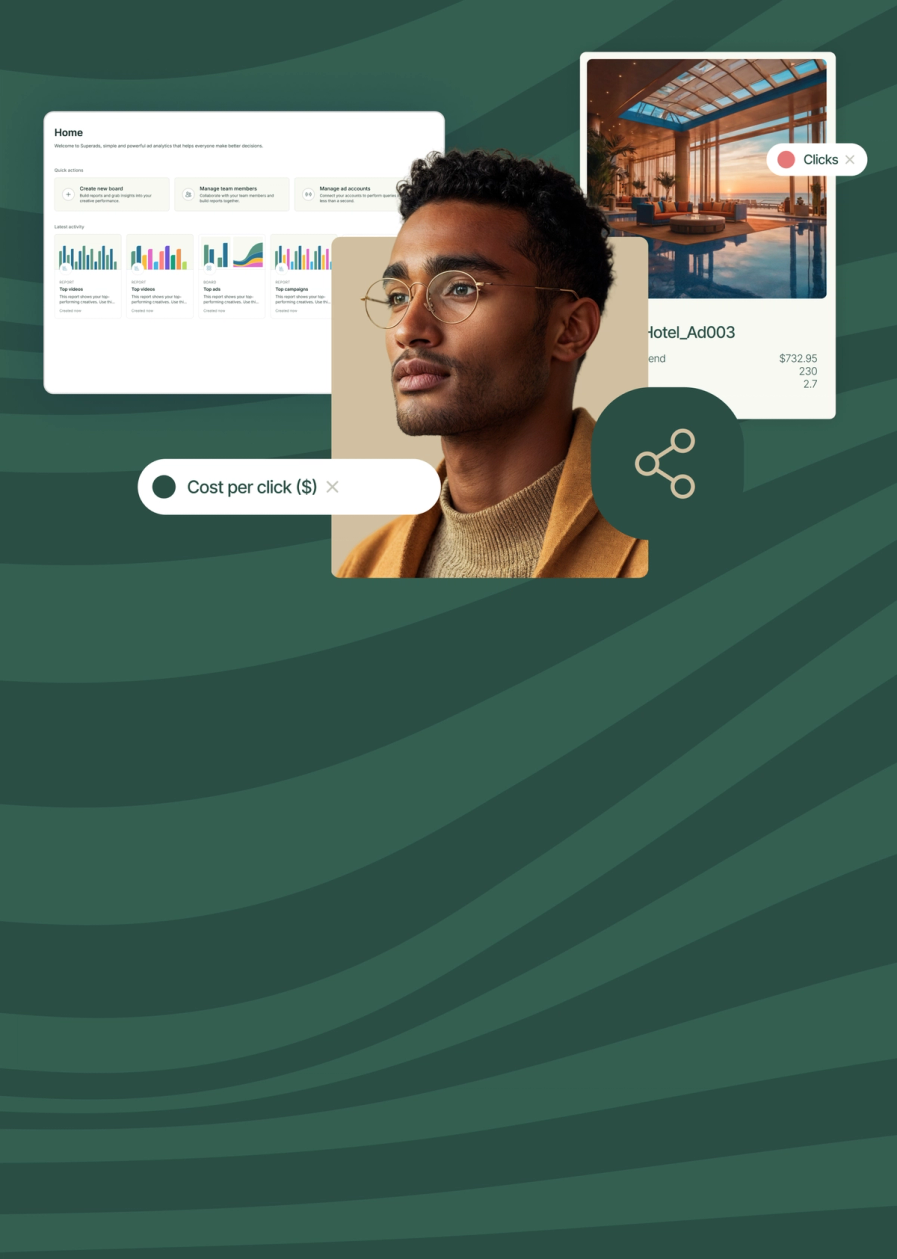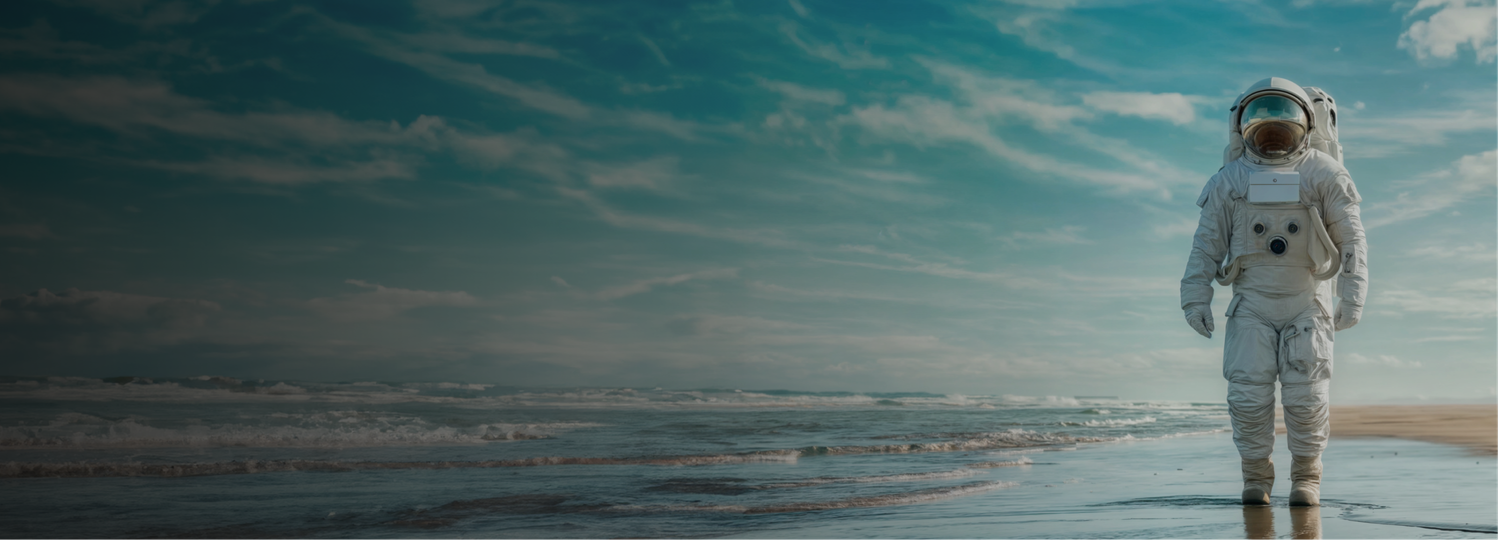
Using Data To Drive Creative Performance
Published 7 Oct, 2024
Data and creativity are twin pillars of successful campaigns. Today’s top marketing teams are using the best analytical and creative brains on their teams to max out on both. Not using data efficiently to drive creative performance? Discover how to supercharge your ad campaigns with knockout design and data-driven insights.
It’s every marketing team’s worst nightmare: You launch a carefully crafted campaign—one you’ve worked on for weeks—only to see close-to-zero engagement when you check your reports. It’s all part of the marketing game, as is picking yourself up, taking a deep breath and figuring out how to do better next time.
Fortunately, several powerful analytics tools are available today to help you produce the best creative content for your campaigns. Whether your goal is brand awareness, lead generation or sky-high conversion rates, data is your friend.
Integrating data analytics into your creative workflow has become critical to campaign success. This article explores how metrics and data are linked to creative production and how to use data-backed insights to breathe new life into your ad campaigns.
The Role of Data in Creative Success
High-quality ad creative is a key driver of performance marketing success. In fact, Google notes that 70% of a campaign’s performance can be attributed directly to the quality of the creative.
But creativity can feel like a mysterious process, and it’s sometimes hard to establish if one creative element will make or break a campaign. To get eyeballs on your ads, it’s best to understand precisely what drives results and what doesn’t.
Creative performance data is a powerful asset for marketers. Robust data helps you quantify your campaign’s performance and gives you accurate insights into the success of your designs.
This information-gathering process is the foundation of practices like A/B testing and campaign iteration. Both can, for example, help you push past ad fatigue and rope in more leads.
Ultimately, the insights from your data can bring you superior campaign performance. Creativity, intuition and experience are important creative tools, but they become especially powerful when combined with data-driven decision making.
Data eliminates guesswork in the campaign planning and execution process, giving you a clear view of how to optimize your ad creative for success.
Creative Performance vs. Performance Creative
You might have heard the terms “creative performance” and “performance creative” bandied about, but what do they mean? And is there a difference between the two?
- Creative performance refers to how well your ads and other creative assets meet your campaign’s goals. Before the digital age, advertising and marketing success was, to a large extent, measured by intuition (remember the “spray-and-pray” approach?). Creative performance, on the other hand, is about blending data-driven insights and superb design and creativity for killer results. It’s the measure of how effectively your ad content drives key metrics like engagement, clicks and conversions while advancing the campaign’s overall goals.
- Performance creative, meanwhile, is about your creative concepts and assets themselves and the extent to which data insights inform them. A focus on performance creative means intentionally crafting ads that can bring measurable results.
In short, while creative performance looks at the actual results your assets deliver, performance creative focuses on using data to create more effective assets from the start. The two concepts are closely related but come into play at different stages of the marketing process.
Key Creative Performance Data Types
Several types of metrics play a role in analyzing creative performance. You might choose to focus on a narrow selection of these or look more generally at how your ad is performing across the board.
Selecting and tweaking your metrics allows you to build your attribution model—a framework that determines how much weight you give each type of customer interaction.
In other words, you get to create your own definition of “success,” whether that involves a lift in video views or higher click-through rates via a call-to-action button.
Performance data
Performance data includes the main metrics marketers track to assess campaign success. These typically include:
- Click-through rate (CTR): The percentage of users who clicked on an ad.
- Conversion rate: The percentage of users who completed a desired action, such as buying a product or signing up for a newsletter.
- Engagement rate: The number of likes, shares, comments and video views generated by the ad or post.
- Ad frequency rate: The number of times your audience viewed the ad.
Importantly, you can also use data to measure the cost-effectiveness of your ad campaign. Metrics such as cost per thousand (CPM) impressions, total spend, cost per conversion (CPC), cost per action (CPA) and return on advertising spend (ROAS) can help you determine this.
Note that these metrics don’t necessarily tell you why a particular ad is achieving its goals. Still, they help you to see how your creative assets perform, where you could improve, and if your budget is being spent effectively.
Audience insights
The success of your ads ultimately depends on the relationship they create with your audience.
To get this right, you need to know your audience and how they behave. Audience insights provide data on your audience demographics, preferences and how target customers will likely interact with your ad.
Once you have this information in hand, you can tailor your ad creative to speak directly to specific audiences.
For example, you might want to segment your audience by age, location, interests or behaviors. Data-driven audience insights can help you achieve this, ensuring your ad creative communicates the right message to a specific group of target customers at the right time and on the most appropriate platform.
Creative metrics
Creative metrics focus on the elements that make up your ad. This is where creative performance data meets creative analytics, giving you insight into how specific design choices impact your ad’s success.
Elements like your ad’s visual components, messaging, and format need careful consideration. Ask yourself:
- Does changing the button from black to green affect your CTR?
- Will motion graphics drive conversions faster than static images?
- What happens if you reduce the amount of text?
- Does your target audience respond better to the ad?
Questions about creative metrics are most commonly answered through A/B testing. This process involves running two versions (an “A” and a “B” version) of an ad with one changed variable, such as the headline or image choice. By tracking interactions and metrics across the two versions in real time, you can immediately judge the impact of your creative choices.
How To Use Data in Creative Decision-Making
A smart combination of performance data and audience insights can give you the insights you need to ensure your next ad campaign lands where you need it to.
But your data is only helpful if you know how and where to apply it to your creative processes. Here are five tips for ensuring your data supercharges your creative decision-making:
1. Collect data efficiently
The first step is to make sure you collect the right data as efficiently as possible. Tools like Google Analytics, Meta Ads Manager, and Superside’s new SuperAds platform are great starting points for gathering performance data.
These and other specialized creative analytics tools let you track engagement, impressions, conversion rates and other metrics to get a clear picture of your ads’ performance.
If you pick the right tools and methods, you can also assess which elements of your creative improve campaign performance. Tapping into the data will help you make the best creative decisions.
2. Cross the data-creative divide
To create effective ads in today's digital-led world, you need to establish a culture of collaboration between your data analysts and creative designers.
Teamwork will ensure that your data informs the creative process without stifling it. Both capabilities are necessary to launch new data-driven marketing campaigns and replicate past success.
3. Optimize continuously and implement real-time feedback loops
Good data allows you to incorporate new insights into your decisions for original, dynamic creative. This keeps your ad creative alive, avoiding fatigue among target customers.
Ongoing and evolving data means you can set up real-time feedback loops, monitor ad performance and refine elements as you go. Continuous optimization allows your team to pivot quickly and respond accurately to what’s working and what isn’t.
4. Do pre-test and tap into predictive analysis
One of the most exciting aspects of producing data-led creative is its ability to cut through the guesswork. This is especially important when time is of the essence—and you can’t afford a misstep. Historical data can help you predict which creative elements are likely to perform, informing future creative decisions.
Robust data also allows for “pre-testing,” helping you to evaluate the likely success of different ad variations before hitting “publish.” This goes hand in hand with predictive analysis, which uses past performance to forecast future results.
This proactive, data-driven approach inevitably leads to more effective creative choices.
5. Use automated tools and AI
AI and automated analytics are brilliant tools for streamlining the evaluation of your creative assets.
AI-powered creative analytics lets you look at performance data at any scale, and the latest tools can shape recommendations for subsequent actions while your campaigns are unfolding. Automation lets you spot patterns and trends quickly for faster, more targeted decision-making.
Where You Can Apply Data-Backed Insights to Your Creative
Three main design elements trigger ad breakthrough and drive success: relevance, originality and impact. Knowing how and where to apply data-driven insights to optimize these elements will transform how you create and manage your ad creative.
If you continue to apply these insights, you’ll succeed in growing your brand. You’ll be better positioned to cut through noisy, saturated channels to reach your target audience.
Let’s take a closer look at how these elements improve ad performance:
Balancing Data With Creativity for Maximum Impact
The most successful ad campaigns balance creativity and data. Data informs creativity, while creativity brings data to life. This powerhouse combination leads to impactful, high-performing campaigns that stand out and deliver results.
Once you understand how closely data and creativity work together, it’s a no-brainer to see why the most effective marketing and advertising teams embrace both aspects in every ad campaign they produce.
If your creative team can get behind the importance of data analysis, you’ve won half the battle for sustained performance improvement. Integrating data into the creative process means your teams can fine-tune their design work and messaging based on genuine insight rather than assumptions or best guesses.
Data also doesn’t have to limit or stifle creativity. It supports it as a solid foundation for decisions, effective experimentation and purposeful iteration. By combining the two, you can look forward to a strong return on investment (ROI), return on ad spend (ROAS) and cost of customer acquisition (CAC).
If you can use data to increase your ROI and ROAS while lowering your CAC, you’re already steps ahead of the pack.
Data-Driven Creative Performance Examples
To help you understand the impact data can have on your creative strategies, here are a few examples of data-led creative innovation:
1. Equiti: Lead generation through personalized customer journeys
Dubai-based online trading firm Equiti Brokerage tested the impact of a more conversational, customer-friendly lead generation experience. Traditionally, their ads directed potential customers to a website contact form. They introduced a new approach using Facebook and Instagram ads to link customers to a direct messaging conversation straight from the advert.
These ads were focused on impressions (hence, ad design became a key indicator for conversions) that made leads go down through the funnel and learn more about the brand and its products.
This step immediately created a more organic, personalized interaction between the customer and the brand. In fact, data from A/B testing designs showed it led to a 36% increase in leads, a 27% lower cost per lead and a 46% increase in ad reach.
2. MilliporeSigma: Increased engagement by focusing on people over products
MilliporeSigma, a long-established German life sciences company, decided to test the impact of elevating its overall brand identity instead of running product-specific campaigns. They wanted to be engaging and people-centered, building more authentic relationships with their target audience.
The brand's marketing team tested this approach with a lighthearted LinkedIn campaign called “Science is Everywhere,” which increased engagement by 55%.
This impact data is now driving the company’s future marketing strategies and designs, expanding the focus on authentic, relatable content across other business areas.
3. PointCard: A/B testing for fast, effective experimentation
Fintech brand PointCard approached Superside to help connect with new audiences while keeping their established brand voice consistent. Backed by data-driven insights and A/B testing, they launched a series of creative experiments with different design concepts, messaging and graphics across social channels.
Working as an extension of PointCard’s creative team, Superside used these data insights to inform quick pivots and iterative changes. This allowed us to quickly produce hundreds of new creative assets, balancing innovation with brand consistency.
The results were remarkable: A 240% increase in CTR and a 275% improvement in conversion rates. Superside’s innovative combination of strategic collaboration, rapid testing cycles and the ability to execute high-quality design at scale was essential to maximizing PointCard's creative performance.
Drive Data-Powered Creative Success With Superside
Data-driven creative performance is your new marketing superpower. It will help you achieve better ad results, more engagement and unsurpassed campaign outcomes. Start mobilizing your data today to make smarter decisions, fuel creativity and drive superior ad performance. You have nothing to lose.
At Superside, we help you create and execute large-scale, high-impact campaigns. Our team can act as an extension of yours, whether you’re looking for traditional ad design or cutting-edge AI-powered solutions.
Our end-to-end services cover everything from concept development and strategy to impact measurement and ongoing iteration, ensuring your campaigns stay fresh, compelling and 100% aligned with your goals.
Let our strategic experts and best-in-class creatives produce your next engaging, data-driven creative campaign. Book a call to learn more.
Michelle enjoys learning from and empowering ambitious marketers and creatives focused on scaling design and fueling growth.🚀 With more than two decades of experience, she’s worked at both agencies and in-house teams at companies of all sizes in the United States and Canada. She began her career as an advertising copywriter, remastering these skills as a content marketer and becoming a subject matter expert on everything from frozen pies and financial statements to SaaS and now CaaS. Connect with her on LinkedIn.
















